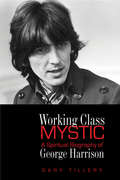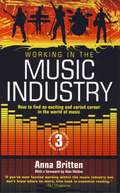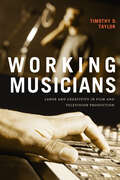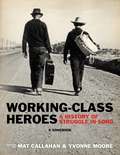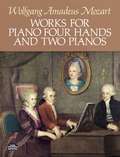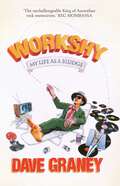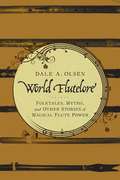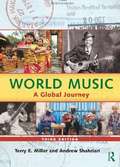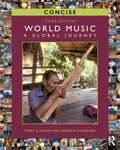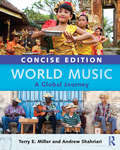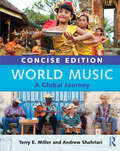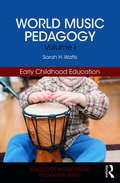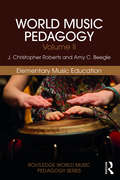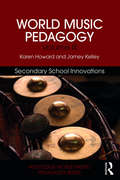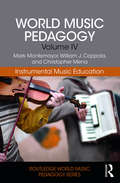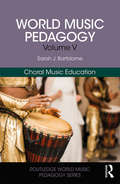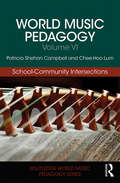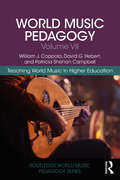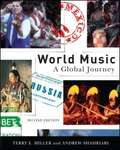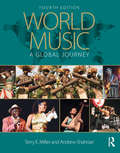- Table View
- List View
Working Class Mystic
by Gary TilleryJohn Lennon called himself a working class hero. George Harrison was a working class mystic. Born in Liverpool as the son of a bus conductor and a shop assistant, for the first six years of his life he lived in a house with no indoor bathroom. This book gives an honest, in-depth view of his personal journey from his blue-collar childhood to his role as a world-famous spiritual icon.Author Gary Tillery's approach is warmly human, free of the fawning but insolent tone of most rock biographers. He frankly discusses the role of drugs in leading Harrison to mystical insight but emphasizes that he soon renounced psychedelics as a means to the spiritual path. It was with conscious commitment that Harrison journeyed to India, studied sitar with Ravi Shankar, practiced yoga, learned meditation from the Maharishi Mahesh Yogi, and became a devotee of Hinduism. George worked hard to subdue his own ego and to understand the truth beyond appearances. He preferred to keep a low profile, but his empathy for suffering people led him to spearhead the first rock-and-roll super event for charity. And despite his wealth and fame, he was always delighted to slip on overalls and join in manual labor on his grounds. At ease with holy men discussing the Upanishads and the Bhagavad Gita, he was ever the bloke from Liverpool whose father drove a bus, whose brothers were tradesmen, and who had worked himself as an apprentice electrician until the day destiny called.Tillery's engaging narrative depicts Harrison as a sincere seeker who acted out of genuine care for humanity and used his celebrity to be of service in the world. Fans of all generations will treasure this book for the inspiring portrayal it gives of their beloved "quiet" Beatle.
Working Girl Blues: The Life and Music of Hazel Dickens (Music in American Life)
by Bill C Malone Hazel DickensHazel Dickens is an Appalachian singer and songwriter known for her superb musicianship, feminist country songs, union anthems, and blue-collar laments. Growing up in a West Virginia coal mining community, she drew on the mountain music and repertoire of her family and neighbors when establishing her own vibrant and powerful vocal style that is a trademark in old-time, bluegrass, and traditional country circles. Working Girl Blues presents forty original songs that Hazel Dickens wrote about coal mining, labor issues, personal relationships, and her life and family in Appalachia. Conveying sensitivity, determination, and feistiness, Dickens comments on each of her songs, explaining how she came to write them and what they meant and continue to mean to her. Bill C. Malone's introduction traces Dickens's life, musical career, and development as a songwriter, and the book features forty-one illustrations and a detailed discography of her commercial recordings.
Working In The Music Industry: How To Find An Exciting And Varied Career In The World Of Music
by Anna BrittenThe music industry is one of the most exciting, glamorous and fun places you could ever work in. It's also a fiercely competitive world, both for jobseekers and those already on the inside. But opportunities arise constantly, and are within the grasp of almost anyone with a true passion for music and a hard-working attitude. This book aims to help you take your first step into what will hopefully be a long and satisfying career in an endlessly fascinating world. Each chapter covers a field of work within the music industry - from record companies to recording studios to roadies - and is crammed with honest, realistic, practical and helpful advice. Insider secrets and individual case studies throw even more light on the subject.Contents: Acknowledgements; Foreword by Alan McGee; Preface; 1. An overview of the Music Industry; 2. Getting a Job; 3. Record Companies; 4. Music Publishing; 5. Music PR and Plugging; 6. Artist Managers; 7. Live Music: Booking Agents, Concert Promoters, Tour Managers and Roadies; 8. Music Journalism; 9. Recording Studios: Record Producers, Sound Engineers and Studio Managers; 10. Music Retail; Glossary; Useful Addresses; Further Reading; Index.
Working In The Music Industry: How To Find An Exciting And Varied Career In The World Of Music
by Anna BrittenThe music industry is one of the most exciting, glamorous and fun places you could ever work in. It's also a fiercely competitive world, both for jobseekers and those already on the inside. But opportunities arise constantly, and are within the grasp of almost anyone with a true passion for music and a hard-working attitude. This book aims to help you take your first step into what will hopefully be a long and satisfying career in an endlessly fascinating world. Each chapter covers a field of work within the music industry - from record companies to recording studios to roadies - and is crammed with honest, realistic, practical and helpful advice. Insider secrets and individual case studies throw even more light on the subject.Contents: Acknowledgements; Foreword by Alan McGee; Preface; 1. An overview of the Music Industry; 2. Getting a Job; 3. Record Companies; 4. Music Publishing; 5. Music PR and Plugging; 6. Artist Managers; 7. Live Music: Booking Agents, Concert Promoters, Tour Managers and Roadies; 8. Music Journalism; 9. Recording Studios: Record Producers, Sound Engineers and Studio Managers; 10. Music Retail; Glossary; Useful Addresses; Further Reading; Index.
Working Musicians: Labor and Creativity in Film and Television Production
by Timothy D. TaylorIn Working Musicians Timothy D. Taylor offers a behind-the-scenes look at the labor of the mostly unknown composers, music editors, orchestrators, recording engineers, and other workers involved in producing music for films, television, and video games. Drawing on dozens of interviews with music workers in Los Angeles, Taylor explores the nature of their work and how they understand their roles in the entertainment business. Taylor traces how these cultural laborers have adapted to and cope with the conditions of neoliberalism as, over the last decade, their working conditions have become increasingly precarious. Digital technologies have accelerated production timelines and changed how content is delivered, while new pay schemes have emerged that have transformed composers from artists into managers and paymasters. Taylor demonstrates that as bureaucratization and commercialization affect every aspect of media, the composers, musicians, music editors, engineers, and others whose soundtracks excite, inspire, and touch millions face the same structural economic challenges that have transformed American society, concentrating wealth and power in fewer and fewer hands.
Working-Class Heroes: A History of Struggle in Song: A Songbook
by Mat CallahanWorking-Class Heroes is an organic melding of history, music, and politics that demonstrates with colorful evidence that workers everywhere will struggle to improve their conditions of life. And among them will be workers who share an insight: in order to better our lot, we must act collectively to change the world. This profusely illustrated treasury of song sheets, lyrics, photographs, histories, and biographical sketches explores the notion that our best hope lies in the capacity of ordinary working people to emancipate ourselves and all of humanity. Featuring more than a dozen songwriters, from Joe Hill to Aunt Molly Jackson, Working-Class Heroes delivers a lyrical deathblow to the myth that so-called political songs of the 20th century were being written by intellectuals in New York. The songs collected here have a striking relevance to current affairs and invite us to explore the historical conditions that inspired their creation: systemic crisis, advancing fascism, and the threat of world war. These working-class songwriters showed courage and heroism that is immortal, and such heroes and their work should be celebrated still today. The heroes featured in this collection include Sarah Ogan Gunning, Ralph Chaplin, Woody Guthrie, Ella May Wiggins, Joe Hill, Paul Robeson, John Handcox, Aunt Molly Jackson, Jim Garland, Alfred Hayes, and Joseph Brandon.
Works for Piano Four Hands and Two Pianos (Dover Music For Piano Ser.)
by Wolfgang Amadeus MozartFrom his earliest years. Mozart played piano duets with his sister, and as his musical career progressed he created a small repertoire of masterly four-hand piano compositions that are among the most admired and performed in this distinctive genre.This Dover edition presents six of these choice works, plus two compositions Mozart wrote for two pianos all reprinted from the authoritative Breitkopf & Härtel edition: Sonatas in D Major (K.381/123a), B-flat Major (K.358/186c), F Major (K.497), G Major (K.497a and 500a), and C Major (K.521) and Theme and Variations in G Major (K.501). Also for 2 pianos: Sonata in D Major (K.448/375a) and Fugue in C Minor (K.426). Duet enthusiasts will discover in these charming works the sparkling elegance, varied moods, and fluid textures that constitute the very essence of Mozart's musical personality.
Workshy
by Dave GraneyLegendary Australian showman Dave Graney returns to the page and reveals the lengths he has gone to avoid anything that really feels like work. In his inimitable style, Graney veers from a feckless childhood in blue-collar South Australia, to the punk rock scene of 1980s London, and beer-soaked nights touring Australia where he worked very hard at not working at all.But in slacking off, Graney became one of the hardest working musicians in the industry, constantly evolving, reinventing, staying one step ahead of everyone - even himself. Workshy is half written by Dave Graney the consummate and tireless performer, and half-written by Dave Graney the bludge. The magic is that you're never sure which is which.
World Flutelore: Folktales, Myths, and Other Stories of Magical Flute Power
by Dale A. OlsenIn many places around the world, flutes and the sounds of flutes are powerful magical forces for seduction and love, protection, vegetal and human fertility, birth and death, and other aspects of human and non-human behavior. This book explores the cultural significance of flutes, flute playing, and flute players from around the world as interpreted from folktales, myths, and other stories--in a word, "flutelore." A scholarly yet readable study, World Flutelore: Folktales, Myths, and Other Stories of Magical Flute Power draws upon a range of sources in folklore, anthropology, ethnomusicology, and literary analysis. Describing and interpreting many examples of flutes as they are found in mythology, poetry, lyrics, and other narrative and literary sources from around the world, veteran ethnomusicologist Dale Olsen seeks to determine what is singularly distinct or unique about flutes, flute playing, and flute players in a global context. He shows how and why world flutes are important for personal, communal, religious, spiritual, and secular expression and even, perhaps, existence. This is a book for students, scholars, and any reader interested in the cultural power of flutes.
World Music
by Andrew Shahriari Terry E. MillerAuthors Terry E. Miller and Andrew Shahriari take students around the world to experience the diversity of musical expression. World Music: A Global Journey, now in its third edition, is known for its breadth in surveying the world's major cultures in a systematic study of world music within a strong pedagogical framework. As one prepares for any travel, each chapter starts with background preparation, reviewing the historical, cultural, and musical overview of the region. Visits to multiple 'sites' within a region provide in-depth studies of varied musical traditions. Music analysis begins with an experimental "first impression" of the music, followed by an "aural analysis" of the sound and prominent musical elements. Finally, students are invited to consider the cultural connections that give the music its meaning and life. Features of the Third Edition Over 3 hours of diverse musical examples. with a third audio CD of new musical examples Listening Guides analyze the various pieces of music with some presented in an interactive format online Biographical highlights of performers and ethnomusicologists updated and new ones added Numerous pedagogical aids, including "On Your Own Time" and "Explore More" sidebars, and "Questions to Consider" Popular music incorporated with the traditional Dynamic companion web site hosts new Interactive Listening Guides, plus many resources for student and instructor. Built to serve online courses. The CD set is available separately (ISBN 978-0-415-89402-9) or with its Value Pack and book (ISBN 978 0415- 80823-1). For eBook users, MP3 files for the accompanying audio files are available only with the Value Pack of eBook & MP3 files (ISBN 978-0-203-15298-0). Please find instructions on how to obtain the audio files in the contents section of the eBook.
World Music CONCISE: A Global Journey
by Andrew Shahriari Terry E. MillerWorld Music CONCISE: A Global Journey, Third Edition, explores the diversity of musical expression around the world, taking students across the globe to experience cultural traditions that challenge the ear, the mind, and the spirit. Based on the Fifth Edition of World Music: A Global Journey, this Third CONCISE Edition maintains the text’s familiar travel theme and strong pedagogical framework to serve as an introduction to the many and varied world music traditions, condensing the number of travel "sites" from 69 to 44. These sites are carefully selected from the existing compilation to be representative of all continents and regions. Features Easy-to-follow chapter structure, organized by geographic region Listening Guides, detailed maps, and hundreds of colorful photos Coverage of an eclectic blend of world musics, including both popular and traditional music A robust companion website with audio examples, flashcards, quizzes, and video links—ideal for online coursework Used in classrooms around the globe, World Music: A Global Journey is an internationally acclaimed and best-selling textbook with a student-friendly approach. This Third CONCISE Edition is a fundamental resource for exploring world music and culture.
World Music Concise Edition: A Global Journey - Paperback & CD Set Value Pack
by Andrew Shahriari Terry E. MillerWorld Music: A Global Journey, Concise Edition is an ideal introduction to the diversity of musical expression around the world, taking students across the globe to experience cultural traditions that challenge the ear, the mind, and the spirit. Based on the comprehensive third edition, this concise version offers a brief survey of the world's musical culture within a strong pedagogical framework. As one prepares for any travel, each chapter starts with background preparation, reviewing the historical, cultural, and musical overview of the region. Visits to multiple 'sites' within a region provide in-depth studies of varied musical traditions. Music analysis begins with an experiential "first impression" of the music, followed by an "aural analysis" of the sound and prominent musical elements. Finally, students are invited to consider the cultural connections that give the music its meaning and life. Features A brief survey of the world's musical cultures 43 sites carefully selected for a global balance A 2-CD set of music, a fundamental resource for students to begin their exploration of world music and culture Listening Guides analyzing various pieces of music, with selected examples presented in an interactive format online Popular music incorporated with the traditional The dynamic companion website hosts interactive listening guides, plus many student resources including video, flashcards, practice quizzes, and links to further resources. Instructor resources include assignment ideas, handouts, PowerPoint slides, and a test bank.
World Music Concise Edition: A Global Journey - Paperback Only
by Andrew Shahriari Terry E. MillerWorld Music: A Global Journey, Concise Edition is an ideal introduction to the diversity of musical expression around the world, taking students across the globe to experience cultural traditions that challenge the ear, the mind, and the spirit. Based on the comprehensive third edition, this concise version offers a brief survey of the world’s musical culture within a strong pedagogical framework. As one prepares for any travel, each chapter starts with background preparation, reviewing the historical, cultural, and musical overview of the region. Visits to multiple ‘sites’ within a region provide in-depth studies of varied musical traditions. Music analysis begins with an experiential "first impression" of the music, followed by an "aural analysis" of the sound and prominent musical elements. Finally, students are invited to consider the cultural connections that give the music its meaning and life. Features A brief survey of the world’s musical cultures 43 sites carefully selected for a global balance A 2-CD set of music, a fundamental resource for students to begin their exploration of world music and culture Listening Guides analyzing various pieces of music, with selected examples presented in an interactive format online Popular music incorporated with the traditional The dynamic companion website hosts interactive listening guides, plus many student resources including video, flashcards, practice quizzes, and links to further resources. Instructor resources include assignment ideas, handouts, PowerPoint slides, and a test bank.
World Music Pedagogy, Volume I: Early Childhood Education (Routledge World Music Pedagogy Series)
by Sarah H. WattsWorld Music Pedagogy, Volume I: Early Childhood Education is a resource for music educators to explore the intersection of early childhood music pedagogy and music in cultural contexts across the world. Focusing on the musical lives of children in preschool, kindergarten, and grade 1 (ages birth to 7 years), this volume provides an overview of age-appropriate world music teaching and learning encounters that include informal versus formal teaching approaches and a selection of musical learning aids and materials. It implements multimodal approaches encompassing singing, listening, movement, storytelling, and instrumental performance. As young children are enculturated into their first family and neighborhood environments, they can also grow into ever-widening concentric circles of cultural communities through child-centered encounters in music and the related arts, which can serve as a vehicle for children to know themselves and others more deeply. Centered around playful engagement and principles of informal instruction, the chapters reveal techniques and strategies for developing a child’s musical and cultural knowledge and skills, with attention to music’s place in the development of young children. This volume explores children’s perspectives and capacities through meaningful (and fun!) engagement with music.
World Music Pedagogy, Volume II: Elementary Music Education (Routledge World Music Pedagogy Series)
by J. Christopher Roberts Amy C. BeegleWorld Music Pedagogy, Volume II: Elementary Music Education delves into the theory and practices of World Music Pedagogy with children in grades 1-6 (ages 6-12). It specifically addresses how World Music Pedagogy applies to the characteristic learning needs of elementary school children: this stage of a child’s development—when minds are opening up to broader perspectives on the world—presents opportunities to develop meaningful multicultural understanding alongside musical knowledge and skills that can last a lifetime. This book is not simply a collection of case studies but rather one that offers theory and practical ideas for teaching world music to children. Classroom scenarios, along with teaching and learning experiences, are presented within the frame of World Music Pedagogy. Ethnomusicological issues of authenticity, representation, and context are addressed and illustrated, supporting the ultimate goal of helping children better understand their world through music.
World Music Pedagogy, Volume III: Secondary School Innovations (Routledge World Music Pedagogy Series)
by Karen Howard Jamey KelleyWorld Music Pedagogy, Volume III: Secondary School Innovations provides a rationale and a resource for the implementation of World Music Pedagogy in middle and high school music classes, grades 7–12 (ages 13–18). Such classes include secondary general music, piano, guitar, songwriting, composition/improvisation, popular music, world music, music technology, music production, music history, and music theory courses. This book is not a depository of ready-made lesson plans but rather a tool to help middle and high school teachers to think globally in the music classroom. Strategies and techniques of World Music Pedagogy are promoted by discussions of a multicultural music education, descriptive vignettes of realistic teaching environments, conversations with culture-bearers/pedagogues, and prompts for self-reflection. This volume approaches important issues of multicultural education and social justice that are often neglected in music education texts—proving to be a valuable resource for both nascent music educators and veteran practitioners alike.
World Music Pedagogy, Volume IV: Instrumental Music Education (Routledge World Music Pedagogy Series)
by Mark Montemayor William J. Coppola Christopher MenaWorld Music Pedagogy, Volume IV: Instrumental Music Education provides the perspectives and resources to help music educators craft world-inclusive instrumental music programs in their teaching practices. Given that school instrumental music programs—concert bands, symphony orchestras, and related ensembles—have borne musical traditions that broadly reflect Western art music and military bands, instructors are often educated within the European conservatory framework. Yet a culturally diverse and inclusive music pedagogy can enrich, expand, and transform these instrumental music programs to great effect. Drawing from years of experience as practicing music educators and band and orchestra leaders, the authors present a vision characterized by both real-world applicability and a great depth of perspective. Lesson plans, rehearsal strategies, and vignettes from practicing teachers constitute valuable resources. With carefully tuned ears to intellectual currents throughout the broader music education community, World Music Pedagogy, Volume IV provides readers with practical approaches and strategies for creating world-inclusive instrumental music programs.
World Music Pedagogy, Volume IV: Teaching World Music In Higher Education (Routledge World Music Pedagogy Series)
by Mark Montemayor Christopher Mena William CoppolaWorld Music Pedagogy, Volume IV: Instrumental Music Education provides the perspectives and resources to help music educators craft world-inclusive instrumental music programs in their teaching practices. Given that school instrumental music programs—concert bands, symphony orchestras, and related ensembles—have borne musical traditions that broadly reflect Western art music and military bands, instructors are often educated within the European conservatory framework. Yet a culturally diverse and inclusive music pedagogy can enrich, expand, and transform these instrumental music programs to great effect.Drawing from years of experience as practicing music educators and band and orchestra leaders, the authors present a vision characterized by both real-world applicability and a great depth of perspective. Lesson plans, rehearsal strategies, and vignettes from practicing teachers constitute valuable resources. With carefully tuned ears to intellectual currents throughout the broader music education community, World Music Pedagogy, Volume IV provides readers with practical approaches and strategies for creating world-inclusive instrumental music programs.
World Music Pedagogy, Volume V: Choral Music Education (Routledge World Music Pedagogy Series)
by Sarah J. BartolomeWorld Music Pedagogy, Volume V: Choral Music Education explores specific applications of the World Music Pedagogy process to choral music education in elementary, middle, and high school contexts, as well as within community settings. The text provides clear and accessible information to help choral music educators select, rehearse, and perform a diverse global repertoire. It also guides directors in creating a rich cultural context for learners, emphasizing listening, moving, and playing activities as meaningful music-making experiences. Commentary on quality, commercially available world music repertoire bridges the gap between the philosophy of World Music Pedagogy and the realities of the performance-based choral classroom. All chapters open with a series of vignettes that illuminate the variety of possibilities within multiple K-12 contexts, providing the reader with a sense of how the ideas presented might look "on the ground." Ready-to-integrate activities serve as concrete and pedagogically sound examples to guide directors as they develop their own instructional materials according to the needs of their choir. Content features choral and vocal music-making traditions from South and West Africa; Latin America; Southeast, East, and South Asia; the Pacific Islands; Australia; New Zealand; Scandinavia; and the Baltics.
World Music Pedagogy, Volume VI: School-community Intersections (Routledge World Music Pedagogy Series)
by Patricia Shehan Campbell Chee Hoo LumWorld Music Pedagogy, Volume VI: School-Community Intersections provides students with a resource for delving into the meaning of "world music" across a broad array of community contexts and develops the multiple meanings of community relative to teaching and learning music of global and local cultures. It clarifies the critical need for teachers to work in tandem with community musicians and artists in order to bridge the unnecessary gulf that often separates school music from the music of the world beyond school and to consider the potential for genuine collaborations across this gulf. The five-layered features of World Music Pedagogy are specifically addressed in various school-community intersections, with attention to the collaboration of teachers with local community artist-musicians and with community musicians-at-a-distance who are available virtually. The authors acknowledge the multiple routes teachers are taking to enable and encourage music learning in community contexts, such as their work in after-school academies, museums and libraries, eldercare centers, places of worship, parks and recreation centers, and other venues in which adults and children gather to learn music, make music, and become convivial through music This volume suggests that the world’s musical cultures may be found locally, can be tapped virtually, and are important in considerations of music teaching and learning in schools and community contexts. Authors describe working artists and teachers, scenarios, vignettes, and teaching and learning experiences that happen in communities and that embrace the role of community musicians in schools, all of which will be presented with supporting theoretical frameworks.
World Music Pedagogy, Volume VII: Teaching World Music in Higher Education (Routledge World Music Pedagogy Series)
by Patricia Shehan Campbell David G. Hebert William J. CoppolaWorld Music Pedagogy, Volume VII: Teaching World Music in Higher Education addresses a pedagogical pathway of varied strategies for teaching world music in higher education, offering concrete means for diversifying undergraduate studies through world music culture courses. While the first six volumes in this series have detailed theoretical and applied principles of World Music Pedagogy within K-12 public schools and broader communities, this seventh volume is chiefly concerned with infusing culture-rich musical experiences through world music courses at the tertiary level, presenting a compelling argument for the growing need for such perspectives and approaches. These chapters include discussions of the logical trajectories of the framework into world music courses, through which the authors seek to challenge the status quo of lecture-only academic courses in some college and university music programs. Unique to this series, each of these chapters illustrates practical procedures for incorporating the WMP framework into sample classes. However, this volume (like the rest of the series) is not a prescriptive "recipe book" of lesson plans. Rather, it seeks to enrich the conversation surrounding cultural diversity in music through philosophically-rooted, social justice-conscious, and practice-oriented perspectives.
World Music Pedagogy, Volume VII: Teaching World Music in Higher Education (Routledge World Music Pedagogy Series)
by Patricia Shehan Campbell David G. Hebert William J. CoppolaWorld Music Pedagogy, Volume VII: Teaching World Music in Higher Education addresses a pedagogical pathway of varied strategies for teaching world music in higher education, offering concrete means for diversifying undergraduate studies through world music culture courses. While the first six volumes in this series have detailed theoretical and applied principles of World Music Pedagogy within K-12 public schools and broader communities, this seventh volume is chiefly concerned with infusing culture-rich musical experiences through world music courses at the tertiary level, presenting a compelling argument for the growing need for such perspectives and approaches.These chapters include discussions of the logical trajectories of the framework into world music courses, through which the authors seek to challenge the status quo of lecture-only academic courses in some college and university music programs. Unique to this series, each of these chapters illustrates practical procedures for incorporating the WMP framework into sample classes. However, this volume (like the rest of the series) is not a prescriptive "recipe book" of lesson plans. Rather, it seeks to enrich the conversation surrounding cultural diversity in music through philosophically-rooted, social justice-conscious, and practice-oriented perspectives.
World Music: A Global Journey
by Terry Miller Andrew ShahriariThe second edition of World Music: A Global Journey introduces students to the diversity of musical expression around the world. It takes the reader across the globe to experience cultural traditions that challenge the ear, the mind, and the spirit. It presents a systematic study of varied traditions in a non-technical language accessible to any enthusiast of world music and culture. The second edition continues with its geographical orientation to each locale, and visits each of the seventy musical "sites" with a three-fold listening review that begins with an experiential "first impression" of the music. This is followed by an "aural analysis" of the musical organization and a closer look at the interesting instruments that create the exotic sounds heard. Finally, the authors consider the cultural connections that give the music its meaning. The second edition of World Musicenhances its pedagogical efforts with Listening Guides, an enhanced website, and improved interior design. With nearly 300 photos of instruments and cultural settings, over two hours of music on the accompanying audio CDs, and online resources, World Music: A Global Journey provides a fundamental resource for teachers, students, researchers, musicians, and any enthusiast beginning their exploration of world music and culture.
World Music: A Global Journey
by Andrew Shahriari Terry E. MillerAuthors Terry E. Miller and Andrew Shahriari take students around the world to experience the diversity of musical expression. World Music: A Global Journey, now in its third edition, is known for its breadth in surveying the world's major cultures in a systematic study of world music within a strong pedagogical framework. As one prepares for any travel, each chapter starts with background preparation, reviewing the historical, cultural, and musical overview of the region. Visits to multiple 'sites' within a region provide in-depth studies of varied musical traditions. Music analysis begins with an experimental "first impression" of the music, followed by an "aural analysis" of the sound and prominent musical elements. Finally, students are invited to consider the cultural connections that give the music its meaning and life. Features of the Third Edition Over 3 hours of diverse musical examples. with a third audio CD of new musical examples Listening Guides analyze the various pieces of music with some presented in an interactive format online Biographical highlights of performers and ethnomusicologists updated and new ones added Numerous pedagogical aids, including "On Your Own Time" and "Explore More" sidebars, and "Questions to Consider" Popular music incorporated with the traditional Dynamic companion web site hosts new Interactive Listening Guides, plus many resources for student and instructor. Built to serve online courses. The CD set is available separately (ISBN 978-0-415-89402-9) or with its Value Pack and book (ISBN 978 0415- 80823-1). For eBook users, MP3 files for the accompanying audio files are available only with the Value Pack of eBook & MP3 files (ISBN 978-0-203-15298-0). Please find instructions on how to obtain the audio files in the contents section of the eBook.
